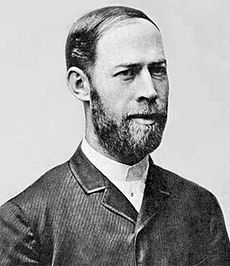Heinrich Hertz
| Heinrich Hertz | |
|---|---|
 | |
| Ìbí | Heinrich Rudolf Hertz 22 Oṣù Kejì 1857 Hamburg, German Confederation |
| Aláìsí | 1 January 1894 (ọmọ ọdún 36) Bonn, German Empire |
| Ibùgbé | Germany |
| Ọmọ orílẹ̀-èdè | German |
| Pápá | Physics Electronic Engineering |
| Ilé-ẹ̀kọ́ | University of Kiel University of Karlsruhe University of Bonn |
| Ibi ẹ̀kọ́ | University of Munich University of Berlin |
| Doctoral advisor | Hermann von Helmholtz |
| Ó gbajúmọ̀ fún | Electromagnetic radiation Photoelectric effect |
Signature | |
Heinrich Rudolf Hertz (22 February 1857 – 1 January 1894) was a German physicist who clarified and expanded James Clerk Maxwell's electromagnetic theory of light, which was first demonstrated by David Edward Hughes using non-rigorous trial and error procedures. Hertz is distinguished from Maxwell and Hughes because he was the first to conclusively prove the existence of electromagnetic waves by engineering instruments to transmit and receive radio pulses using experimental procedures that ruled out all other known wireless phenomena.[1] The scientific unit of frequency — cycles per second — was named the "hertz" in his honor.[2]

|
Àyọkà yìí tàbí apá rẹ̀ únfẹ́ àtúnṣe sí. Ẹ le fẹ̀ jù báyìí lọ tàbí kí ẹ ṣàtúnṣe rẹ̀ lọ́nà tí yíò mu kúnrẹ́rẹ́. Ẹ ran Wikipedia lọ́wọ́ láti fẹ̀ẹ́ jù báyìí lọ. |
Itokasi
[àtúnṣe | àtúnṣe àmìọ̀rọ̀]- ↑ Prof. D. E. Hughes' Research in Wireless Telegraphy, The Electrician, Volume 43, 1899, page 41. See also pages 35, 40, 93, 143–144, 167, 217, 401, 403, 767. Hughes himself said that Hertz's experiments were "far more conclusive than mine".
- ↑ "IEC History". Archived from the original on 2013-05-19. Retrieved 2013-01-01.
